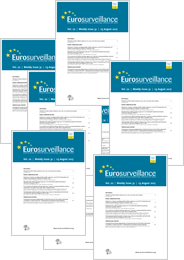- Home
- Weekly releases (1997–2007)
- Previous Issues
- Volume 5, Issue 43, 25/Oct/2001
Weekly releases (1997–2007) - Volume 5, Issue 43, 25 October 2001
Volume 5, Issue 43, 2001
- Articles
-
-
-
Interim guidance on deliberate releases of biological agents in the UK and US
More LessLast week, Eurosurveillance Weekly reported on cases of anthrax and public health guidance in the United States (US) (1). The number of people with confirmed anthrax had risen to 11 by 23 October, but additional cases are being classified as suspect, and yet more people are undergoing evaluation. The numbers of infected people are therefore likely to rise. The most recent cases are in postal and mailroom workers in West Trenton, New Jersey, and Washington DC.
-
-
-
Salmonella Stanley and Salmonella Newport in imported peanuts – update
More LessAn international outbreak of Salmonella Stanley and S. Newport infection associated with consumption of ‘Farmer’ brand peanuts was reported recently in Eurosurveillance Weekly (1). Three countries (Australia, Canada, and the United Kingdom (UK) have reported isolating S. Stanley and/or S. Newport from unopened packets of these peanuts (Shandong peanuts in Australia and Canada; garlic flavoured peanuts in England), which originate in China, and are distributed via Singapore.
-
-
-
Reported incidence of gonorrhoea and syphilis in East and West Germany 1990-2000 – effects of reunification and behaviour change
More LessNumbers of cases of gonorrhoea and, to a lesser extent, of syphilis in Germany may have been drastically underreported in the past, according to a report in Germany’s national surveillance bulletin (1). It is hoped that a new notification system for syphilis, introduced on 1 January 2001, and a sentinel surveillance system for sexually transmitted infections (STIs) soon to be implemented will provide better quality data to estimate the incidence of STIs and find out whether they reflect the situation in other European countries (2-7).
-
-
-
Multidrug resistant tuberculosis – can the tide be turned?
More LessDespite the global increase in tuberculosis and the worrying rise in the number of cases resistant to the two principal antituberculosis drugs, isoniazid and rifampicin, the authors of a personal view in the current issue of the Lancet Infectious Diseases think that if action is taken now this tide can be turned (1).
-
-
-
Rapid reporting EU surveillance system for meningitis W135: 2a: P1.2, 5 – update
S Handford , B Henderson and M RamsayMore LessAfter an epidemic of meningococcal disease caused by Neisseria meningitidis serotype W135 among travellers to the haj pilgrimage to Mecca in 2000, an enhanced surveillance system for serogroup W135: 2a: P1.2, 5 meningococcal disease was set up among several European countries (1, and references therein). Data have been reported since September 2000, and this report summarises all confirmed cases during the period 1 September to 28 September 2001.
-
-
Most Read This Month

-
-
Chikungunya in north-eastern Italy: a summing up of the outbreak
R Angelini , A C Finarelli , P Angelini , C Po , K Petropulacos , G Silvi , P Macini , C Fortuna , G Venturi , F Magurano , C Fiorentini , A Marchi , E Benedetti , P Bucci , S Boros , R Romi , G Majori , M G Ciufolini , L Nicoletti , G Rezza and A Cassone
-
- More Less


